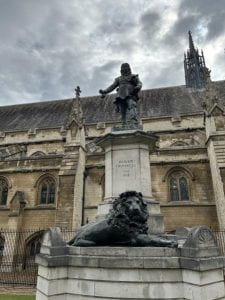On July 19th, I, along with a lively coterie of fellow scholars, made a voyage to London in search of educational and personal fulfillment, and a much needed break from the intense monotonous oppression of trite classroom learning. We all shuffled off the coach into the London air within sight of our first destination: the Parliament building. Southern Methodist University students being of such high scholastic caliber, our soft, tired, voices were reinvigorated and developed a frenetic energy of excitement. We were to step into the halls of power, trodding along the paving stones of the mighty, in our search for knowledge about our summer homeland.
In my stay at Oxford, I have, in part, concerned my studies with the history of India, and Parliament provided great insight into the intertwining of Indian and British history. The legacy of empire is ubiquitous in Britain, but can especially be found in the concentrated wealth of government buildings such as parliament, much of it likely financed by the conquest and exploitation of the colonies including those in South Asia. Within Parliament, there is a hall filled with paintings depicting important moments in British history. One moment depicted is the meeting of the English ambassador with the Mughal emperor, when England first made official contact with India. This painting shows the Mughal emperor seated upon a throne, surrounded by dutiful attendants and his entourage of courtiers and soldiers. Standing straight in front of him, only slightly below, is the English envoy, offering a piece of parchment, curled like a scroll. He is handing the emperor what seems to be a contract or an agreement, which creates the impression that the English came to India utilizing fair, legal, and documented terms of subjugation to the Indians. Similarly, the depiction of the English envoy as about equal to the Mughal emperor serves to discredit local governments in South Asia. By depicting this British man as equal to an Indian emperor, it discredits Indian governments’ legitimacy and strength.
The relationship between Britain and India is also more subtley depicted in Parliament. I noticed the tiling throughout much of Parliament was very strongly inspired by Indian textile motifs. The British presence in India exposed many Britons to Indian art and artistic styles, and with the heightened desire for Indian fashion, Indian styles and motifs became widespread across the United Kingdom. Following trade between India and Britain came people, and by the late 19th century there was a bustling, albeit small, community of South Asians in Great Britain. In 1892, a member of the South Asian community, Dadabhai Naoroji, was first elected to Parliament. He faced intense hardship, and was not respected by his peers, yet fought hard in Parliament against imperialism and imperialist apologia.
Since Naoroji, there have been a great number of South Asian MPs, and recently Rishi Sunak, a man of Indian heritage, became Prime Minister. This has raised complicated questions about the legacy of the empire and about tolerance and race within the UK. Sunak came to power as a man possessing great wealth, moreso even than the King, and his life story and circumstances are not reflective of those of an average person of Indian heritage in the UK. Colonial discrimination also still affects immigration with India, where the rich and educated are easily able to emmigrate, while it is incredibly difficult for members of the working class to leave India for the UK.
Sam Rodick
https://www.bbc.co.uk/news/world-asia-india-52829458
https://www.washingtonpost.com/politics/2022/12/09/rishi-sunak-uk-immigrant-family/


